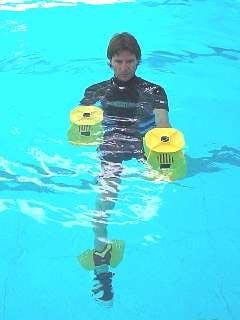
Exercising in water takes much of the pressure off your joints and allows for more movement for those who otherwise may have limited mobility. Whether used as a form of therapy or as an exercise regimen, most people find aquatic exercise to be challenging but not prohibitive.
Water Rehabilitation and Exercise
Vince Newman, P.T. ATRIC., a licensed Physical Therapist and a certified Aquatic Specialist for Water Physical Therapy Specialists, provides aquatic rehabilitation and water exercise programs for patients recuperating from many different types of injuries and health conditions ranging from post-surgical therapy to cardiac health maintenance.
Suitable for All Fitness Levels
Newman believes that everyone can benefit from water exercise - that is, exercise done while in water. Through his experience with multiple physical therapy specialties, he finds aquatic exercise to be one of the most beneficial types of rehabilitation. He says water exercise can help treat health problems and keep people healthy.

Enhancing Treatment
Newman's clinic offers "physical therapy in the water. We treat almost every diagnosis that is treated on land, but in the water environment utilizing all the properties of the water to enhance the treatment process." He adds that water therapy is suitable for "almost every diagnosis with the exceptions of those that water would be a contraindication. Most orthopedic and neurologic medical conditions benefit greatly!"
Less Cardiac Strain
"Exercising in the water allows the heart to work with less strain on it due to the hydrostatic pressure in water assisting blood to return back to the heart," explains Newman. "It has been documented that the heart rate remains at a lower rate while exercising the same exercises at the same level in water as compared to on land. Therefore, it's safer to exercise in water for most people - especially those patients that are cardiovascularly compromised."
Benefits of Aquatic Rehab
Newman says rehabilitation in the water is proactive. "Reduced stress on joints and soft tissues allows for earlier rehab initiation. Reduced pain promotes earlier strengthening." He also says it "reduces atrophy, promotes quicker recovery (and) results in far less residual side effects compared to land PT."

Help for Compromised Patients
Among the other benefits, aquatic rehabilitation and exercise, "allows severely compromised patients, severely obese patients and patients who are very acute and with pain to initiate rehab," says Newman. "It provides immediate pain reduction and exercise initiation."
Injury Rehab
"It allows patients to initiate rehab much earlier with far less stress and associated pain as compared to land physical therapy," says Newman of aquatic rehab for injuries. "This results in less scar production, less atrophy, less cardiovascular decompensation and faster overall recovery."
Aquatics for Fitness
Newman says doing exercises in the water "allows patients to work harder and longer with far less residual stress placed on their body. Both deep water and shallow water for both general cardiovascular training fitness and specific strengthening exercising."

Water Fitness for Weight Loss
When combined with a caloric deficit, water exercise can help you lose weight. It also helps you build strength without profound impact on your joints, making it an ideal form of exercise for everyone.
Resisted Gait Training
"There are quite a few new exercises and physical therapy manual techniques that I created during the 12 years treating in water," says Newman. "One such exercise technique is our resisted gait training. This is where we strap on elastic tubing in a belt worn by the patient and then we have them pull one of the therapists in the water graduating the amount of the resistance according to their ability to ambulate correctly upright and biomechanically correct."
Snorkel Technique
"Another exercise protocol is the mask and snorkel technique where the patient places a mask and snorkel on and performs an assortment of exercises for the shoulder, neck and upper quadrant while eliminating much of the strain on the neck since it's properly aligned in the water," says Newman.
A Safe Option
"I feel exercising in the aquatic environment is the safest form of exercising, while there is the least amount of strain and stress applied to all the weight bearing joints and musculature," says Newman. "This decompressed environment promotes an increased speed in the healing process with less irritating side effects that comes with exercising on land with gravity."
Reduced Impact
"Water is the safest environment to perform exercises," says Newman. "It not only utilizes a type of isokinetic resistive force that helps prevent injury or strain during exercising, but also water supports the body and allows it to fully relax when at rest. The many properties of water stimulates all areas of the body, central nervous system, musculoskeletal system and cardiovascular system, all working together to enhance the healing process."

Pool Activity
Most commonly done in a swimming pool, aqua aerobics classes are a good way to get started with exercising in the water for fun and fitness. Check with a physical therapist if you require rehabilitation to see if therapy in the water is suitable for you and available through the facility you attend.







